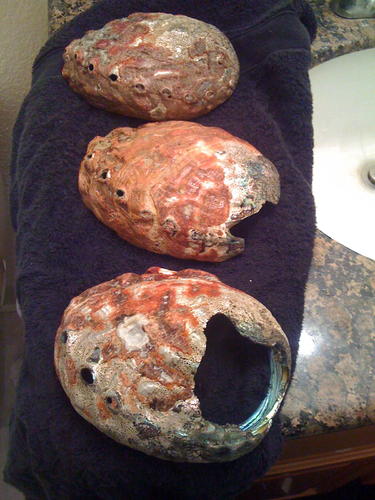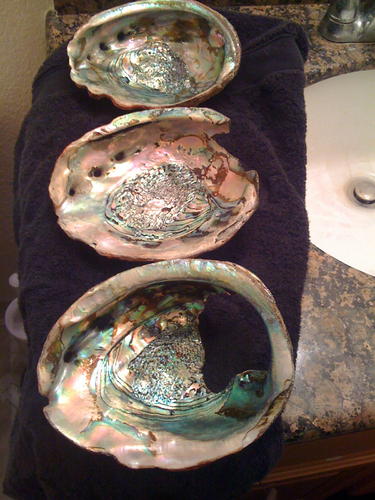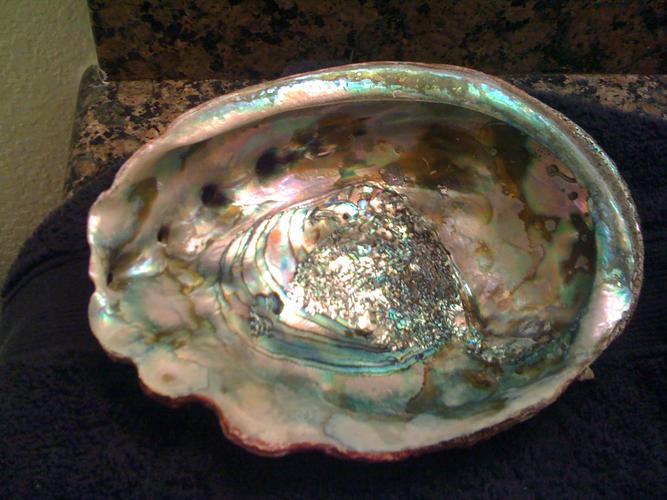Results 1 to 8 of 8
-
02-13-2012, 07:19 PM #1
 Anyone made scales out of abalone shells?
Anyone made scales out of abalone shells?
I was up the coast in california yesterday and I came across a lot of abalone shells, I ended up taking 3 home that were around 10" long and had very straight pieces near the edge. The straight sections are almost half an inch thick and 8" long so I was thinking I could make a few pairs of solid abalone scales. Has anyone ever made scales out of a raw shell before? I tried to search the forum for information but all i could find were what seems like thin pieces glued to acrylic or wood. i saw a few Livi's that appeared to have solid abalone scales, so I'm sure it can be done.
Any suggestions?
-
02-13-2012, 07:49 PM #2

Check out some of "DirtyChrom"s work. He does some great work in that medium.
-
The Following User Says Thank You to coachschaller For This Useful Post:
dirtychrome (02-14-2012)
-
02-14-2012, 01:05 AM #3

I have not been lucky enough to work with solid, one piece, slabs. Just panels. That'll be great if it can be processed to be thick enough as one piece. Vendors I work with, state in general, the larger mollusk's shells aren't really available. I wonder if 10" shell will be big enough to bring down to the min length and thickness you want for slabs, as true and flat. Livi's abalone scales seem to have an organic aspect to them, so likely you will be working around the shells limiting size or imperfections.
If it looks like it will work, wonderful. Shell itself is not difficult to sand or polish. If mating surfaces cant be brought flat, like wedge or pivot, you might get a way filling with colored epoxy, then sanding flat. If the slabs are not evenly thick enough, I would build up a layer of epoxy resin on the inboard side, and sand flat.
You'll want to make wedge with very little angle, or even as a parallel spacer. Scales flexing may crack the brittle shell. Part of a benefit of multi panels is to allow scales to flex at the seams.
Most of my shell work is thin raw shell, sandwiched between g10 liners and clear on show side. My logic with g10 liners is lighter than steel, distributes flex, and uniform bonding to media. Another aspect why I do coating over the top, if dropped counter top, the blow wont be focused directly on one spot of shell and again for flex distribution. I have tried to do one piece thin shell over liners with poor results. The flex has cracked the shell in my use with the thin one piece.
-
02-14-2012, 01:06 AM #4

Thanks for the impute dirtychrome, two of the shells have almost completely straight sides that are half an inch thick and that thickness continues in almost an inch, so if there arn't any serious cracks i should(being optimistic) be able to get a set of scales out of them if I do it right?
There were literally 50 abalone shells with 8"s across all over this beach I was on, if i figure this out maybe i can go get more and make some 4"x1" panels to get to some people. The shells varied in color from pink to bright blue.Last edited by justinA; 02-14-2012 at 01:13 AM.
-
02-14-2012, 01:38 AM #5




They're so much brighter in person, pink on the edges and bright blue green tward the center.
-
02-14-2012, 01:56 AM #6

That many shells strewn around, wonder if that's were some otters enjoy dinner.
You'll want to cut your desired section from the shell, and flat sand for your slabs. Cutting with a dremmel works fine. Flat sanding by hand goes easy. If need to take away lots of material, belt sander is fine too, but easy to go too far. The about the first 1/16' thickness of shell has the most radiance. The more you sand, the more of that is lost. Little worried that shell might be more brittle than normal due to not from a fresh harvest, but I really dont know.
Here are a couple links that show parts of processing shell. You'll probably want to practice on a donator shell first, before doing one of the prize pieces. It has been done for centuries, with much more primitive tools than we use today.
Good luck with it!
Mother of Pearl Box - YouTube
1st Month : Working Process of Thai Mother-of-Pearl Inlaid Cabinet
-
02-14-2012, 02:23 AM #7

They aren't brittle, i was actually messing with a half of one on the beach and I couldn't break it with a roughly 5 lb rock. i have a small piece i just tried hand sanding with 80 grit and it was barely doing anything to it after 10 minutes.
Thanks for the insight and the links, if i figure this out maybe I could send you some pieces to show my appreciation.
-
02-11-2014, 08:39 PM #8Member

- Join Date
- Jan 2014
- Location
- Orange County, NY
- Posts
- 60
Thanked: 10
Those are some beautiful specimens you got there. Any updates ?


 1Likes
1Likes LinkBack URL
LinkBack URL About LinkBacks
About LinkBacks






 Reply With Quote
Reply With Quote